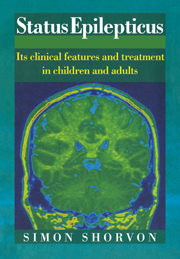Book contents
- Frontmatter
- Contents
- Preface
- 1 The concept of status epilepticus and its history
- 2 Definition, classification and frequency of status epilepticus
- 3 Clinical forms of status epilepticus
- 4 Neurophysiology, neuropathology and neurochemistry of status epilepticus
- 5 Emergency treatment of status epilepticus
- 6 Prognosis and outcome of status epilepticus
- References
- Index
4 - Neurophysiology, neuropathology and neurochemistry of status epilepticus
Published online by Cambridge University Press: 15 September 2009
- Frontmatter
- Contents
- Preface
- 1 The concept of status epilepticus and its history
- 2 Definition, classification and frequency of status epilepticus
- 3 Clinical forms of status epilepticus
- 4 Neurophysiology, neuropathology and neurochemistry of status epilepticus
- 5 Emergency treatment of status epilepticus
- 6 Prognosis and outcome of status epilepticus
- References
- Index
Summary
Scientific investigation of the mechanisms of status focused upon first neuropathology, then electroencephalography and neurophysiology, and in the past two decades also neurochemistry and neuropharmacology. In the future, molecular genetic studies in epilepsy seem likely to flourish, although as yet these are scarcely begun. In this chapter, I consider the basic human and experimental research concerned with status in the fields of neurophysiology, neuropathology and neurochemistry in an attempt to provide a synthesis and overview of current ideas.
Although Bourneville had described Ammon's horn sclerosis in 1876, Pfleger (1880) is generally credited with the earliest detailed pathological study of a patient dying in status. He identified abnormalities, especially in the hippocampus, which have been confirmed many times since. The lesions, both macroscopic and microscopic, were patently slight, and contemporary thought was summed up by Gowers (1888) in his usual prescient manner: ‘the changes in the nerve centres are probably of that fine kind which is revealed only by altered function and eludes the most minute research’. Pathology has made erratic progress since Pfleger's early report, as is reviewed later in this chapter, but Gower's statement still applies largely today. The contrast between the spectacular clinical appearances of status and the minor findings of morbid anatomy is quite disconcerting.
- Type
- Chapter
- Information
- Status EpilepticusIts Clinical Features and Treatment in Children and Adults, pp. 139 - 174Publisher: Cambridge University PressPrint publication year: 1994
- 1
- Cited by



